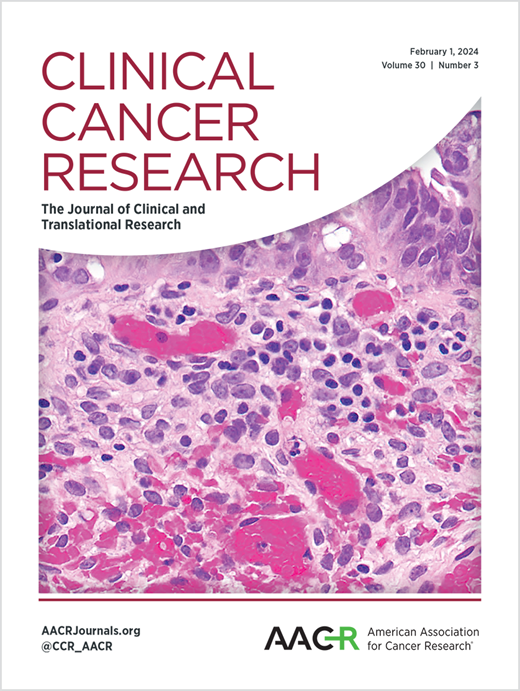Azacitidine, Venetoclax and Magrolimab in Newly Diagnosed and Relapsed Refractory Acute Myeloid Leukemia: Phase 1b/2 Study and Correlative Analysis
IF 10
1区 医学
Q1 ONCOLOGY
引用次数: 0
Abstract
Purpose: Magrolimab is a monoclonal antibody directed against macrophage checkpoint CD47 on myeloid leukemia cells that was pre-clinically synergistic with azacitidine-venetoclax, warranting further clinical evaluation. Patients and Methods: In this phase 1b/2 study the triplet combination of azacitidine, venetoclax and magrolimab was evaluated in adult patients with frontline (ineligible for intensive chemotherapy) and relapsed/refractory AML. Azacitidine was dosed at 75mg/m2 for 7 days, venetoclax at 400 mg/day for 28 days, and magrolimab (recommended phase 2 dose [RP2D]) as follows: 1 mg/kg dose on days 1 and 4, 15 mg/kg on day 8, 30 mg/kg on day 11, 15 and 22 (cycle 1), followed by 30 mg/kg weekly for cycle 2, then 30 mg/kg every 2 weeks cycle 3 and beyond. The primary endpoint was RP2D for phase 1b and rates of composite complete response (CRc) in phase 2. Results: The frontline cohort included 54 patients (median age 70.1 years); 35 (64.8%) were TP53 mutated (TP53mut). CRc was attained in 34 patients (63%); 49% in TP53mut and 90% in the TP53 wild-type patients. At a median follow-up of 27.9 months, the median event free survival (EFS) and overall survival (OS) was 6.6 months and 9.8 months respectively; for TP53mut patients the median EFS and OS was 5.9 and 7.6 months, while for TP53 wild type it was 9.6 months and 13 months respectively. CRc in the relapsed/refractory cohort (n=52) was 29% and median OS was 3.9 months. The regimen was well tolerated; infections were the most common ≥ grade 3 adverse event (75.4%) with no immune toxicities or deaths related to therapy. scRNAseq was performed on 27 longitudinal samples from 11 TP53mut patients (8 responders). Gene set enrichment analysis revealed enrichment of IFNγ and TNFα signaling in non-responders at baseline, while erythroid differentiation was associated with resistance. Patients at relapse also showed up-regulated CD47 expression and elevated leukemia regeneration score. Conclusions: The triplet regimen was safe but did not lead to promising survival outcomes.阿扎胞苷、Venetoclax和美格罗单抗治疗新诊断和复发难治性急性髓系白血病:1b/2期研究及相关分析
目的:Magrolimab是一种针对骨髓白血病细胞巨噬细胞检查点CD47的单克隆抗体,与阿扎胞苷-venetoclax临床前协同,需要进一步的临床评估。患者和方法:在这项1b/2期研究中,对阿扎胞苷、venetoclax和magolimab三联用药在一线(不适合强化化疗)和复发/难治性急性髓性白血病(AML)的成年患者进行了评估。阿扎胞苷以75mg/m2的剂量给药7天,venetoclax以400mg /天的剂量给药28天,而马格罗单抗(推荐的2期剂量[RP2D])如下:第1天和第4天剂量为1mg /kg,第8天剂量为15mg /kg,第11、15和22天剂量为30mg /kg(第1周期),第2周期每周剂量为30mg /kg,然后每2周30 mg/kg,第3周期及以后。主要终点是1b期的RP2D和2期的复合完全缓解率(CRc)。结果:一线队列包括54例患者(中位年龄70.1岁);TP53突变(TP53mut) 35例(64.8%)。34例(63%)患者结直肠癌;TP53mut患者为49%,野生型患者为90%。在27.9个月的中位随访中,中位无事件生存期(EFS)和总生存期(OS)分别为6.6个月和9.8个月;TP53mut患者的中位EFS和OS分别为5.9和7.6个月,而TP53野生型患者的中位EFS和OS分别为9.6个月和13个月。复发/难治性队列(n=52)的CRc为29%,中位OS为3.9个月。该方案耐受性良好;感染是最常见的≥3级不良事件(75.4%),无免疫毒性或与治疗相关的死亡。对11名TP53mut患者(8名应答者)的27份纵向样本进行scRNAseq。基因集富集分析显示,基线时无应答者IFNγ和TNFα信号富集,而红细胞分化与耐药相关。复发患者也表现出CD47表达上调和白血病再生评分升高。结论:三胞胎方案是安全的,但没有带来有希望的生存结果。
本文章由计算机程序翻译,如有差异,请以英文原文为准。
求助全文
约1分钟内获得全文
求助全文
来源期刊

Clinical Cancer Research
医学-肿瘤学
CiteScore
20.10
自引率
1.70%
发文量
1207
审稿时长
2.1 months
期刊介绍:
Clinical Cancer Research is a journal focusing on groundbreaking research in cancer, specifically in the areas where the laboratory and the clinic intersect. Our primary interest lies in clinical trials that investigate novel treatments, accompanied by research on pharmacology, molecular alterations, and biomarkers that can predict response or resistance to these treatments. Furthermore, we prioritize laboratory and animal studies that explore new drugs and targeted agents with the potential to advance to clinical trials. We also encourage research on targetable mechanisms of cancer development, progression, and metastasis.
 求助内容:
求助内容: 应助结果提醒方式:
应助结果提醒方式:


